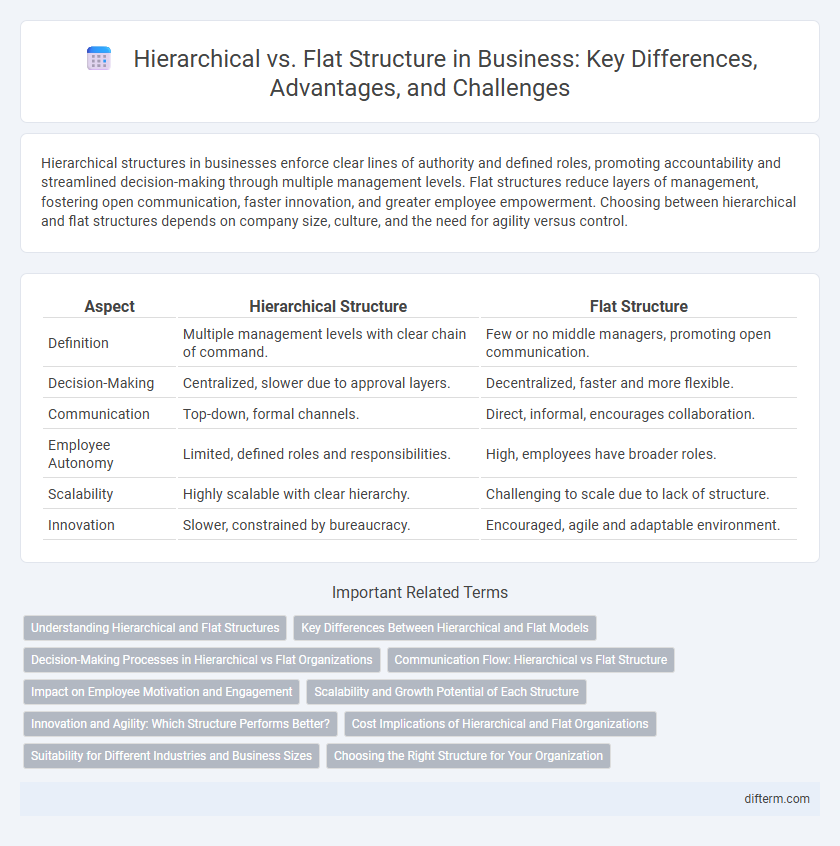Hierarchical structures in businesses enforce clear lines of authority and defined roles, promoting accountability and streamlined decision-making through multiple management levels. Flat structures reduce layers of management, fostering open communication, faster innovation, and greater employee empowerment. Choosing between hierarchical and flat structures depends on company size, culture, and the need for agility versus control.
Table of Comparison
| Aspect | Hierarchical Structure | Flat Structure |
|---|---|---|
| Definition | Multiple management levels with clear chain of command. | Few or no middle managers, promoting open communication. |
| Decision-Making | Centralized, slower due to approval layers. | Decentralized, faster and more flexible. |
| Communication | Top-down, formal channels. | Direct, informal, encourages collaboration. |
| Employee Autonomy | Limited, defined roles and responsibilities. | High, employees have broader roles. |
| Scalability | Highly scalable with clear hierarchy. | Challenging to scale due to lack of structure. |
| Innovation | Slower, constrained by bureaucracy. | Encouraged, agile and adaptable environment. |
Understanding Hierarchical and Flat Structures
Hierarchical structures feature multiple management layers, promoting clear authority and specialized roles but potentially slowing decision-making and communication. Flat structures reduce the number of management levels, fostering faster decision-making, increased collaboration, and greater employee empowerment. Understanding these differences helps businesses align organizational design with their strategic goals and operational efficiency.
Key Differences Between Hierarchical and Flat Models
Hierarchical structures feature multiple management layers, emphasizing clear authority and chain of command, which enhances control but may slow decision-making. Flat structures reduce management levels, promoting employee autonomy and faster communication, ideal for agile and innovative environments. Key differences include complexity, communication flow, and decision speed, impacting organizational flexibility and efficiency.
Decision-Making Processes in Hierarchical vs Flat Organizations
Hierarchical organizations feature multi-tiered decision-making where authority is centralized, ensuring clear accountability but often slowing response times. Flat organizations promote decentralized decision-making, empowering employees at various levels to act swiftly and innovate, enhancing agility. This structural difference significantly affects organizational speed, flexibility, and employee engagement in decision processes.
Communication Flow: Hierarchical vs Flat Structure
Communication flow in hierarchical structures typically follows a top-down approach, where information moves through multiple levels of management, often causing delays and potential distortions. In flat structures, communication is more direct and transparent, enabling faster decision-making and enhanced collaboration across teams. This streamlined interaction fosters agility and responsiveness, crucial for dynamic business environments.
Impact on Employee Motivation and Engagement
Hierarchical structures often limit employee motivation and engagement due to rigid roles and slow decision-making processes, which can stifle creativity and autonomy. Flat structures promote greater employee involvement by encouraging open communication and faster feedback loops, fostering a sense of ownership and collaboration. Organizations with flat hierarchies typically experience higher job satisfaction and increased innovation among their workforce.
Scalability and Growth Potential of Each Structure
Hierarchical structures provide clear roles and responsibilities, which support scalability by enabling systematic delegation and efficient management of expanding teams. Flat structures foster faster decision-making and increased agility, attracting innovative growth but may struggle with scalability as organizations grow larger and require more coordination. Choosing between these organizational models depends on balancing the need for control with the flexibility required for sustained business growth.
Innovation and Agility: Which Structure Performs Better?
Hierarchical structures often slow decision-making due to multiple approval layers, limiting innovation and reducing agility in response to market changes. Flat structures empower employees with greater autonomy, fostering faster communication and a more dynamic environment where innovative ideas can quickly be tested and implemented. Data shows companies with flat hierarchies report higher rates of product development speed and adaptive capacity in fast-paced industries.
Cost Implications of Hierarchical and Flat Organizations
Hierarchical organizations typically incur higher costs due to multiple management layers requiring increased salaries, administrative support, and complex communication channels. Flat organizations reduce overhead expenses by minimizing managerial roles, fostering faster decision-making and streamlined operations. Cost efficiency in flat structures often leads to improved resource allocation and enhanced adaptability in dynamic business environments.
Suitability for Different Industries and Business Sizes
Hierarchical structures suit large corporations and industries with complex operations, such as manufacturing, healthcare, and finance, where clear authority and specialized roles are essential. Flat structures perform well in startups, tech companies, and creative industries that prioritize agility, innovation, and rapid decision-making. Business size influences structure choice; larger companies benefit from hierarchical chains of command, while smaller businesses thrive with flat, flexible teams.
Choosing the Right Structure for Your Organization
Choosing the right organizational structure significantly impacts communication efficiency and decision-making speed. Hierarchical structures offer clear authority lines and defined roles, enhancing control in large companies, while flat structures promote flexibility and faster collaboration, benefiting startups and creative teams. Evaluating company size, culture, and strategic goals ensures the chosen structure aligns with operational needs and drives sustainable growth.
hierarchical structure vs flat structure Infographic

 difterm.com
difterm.com